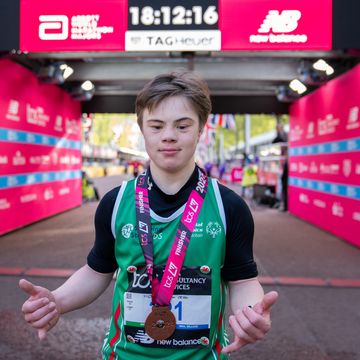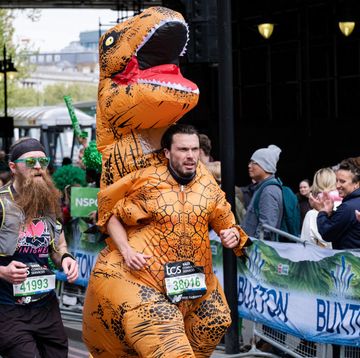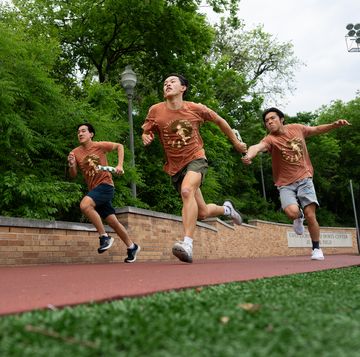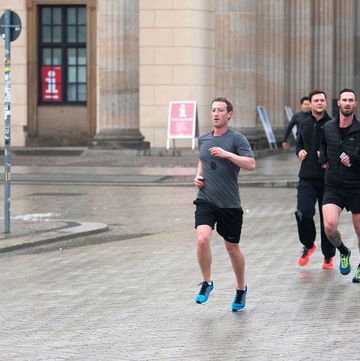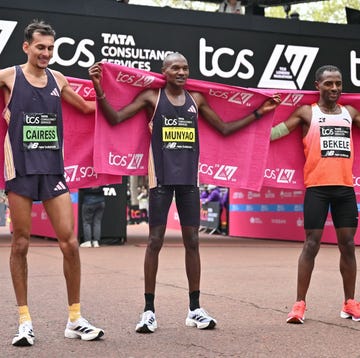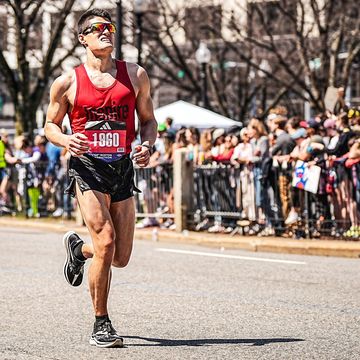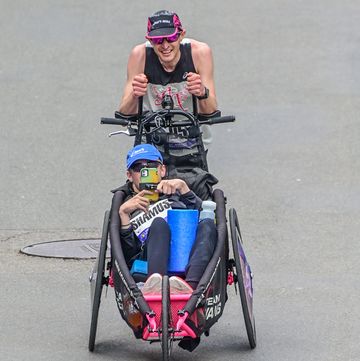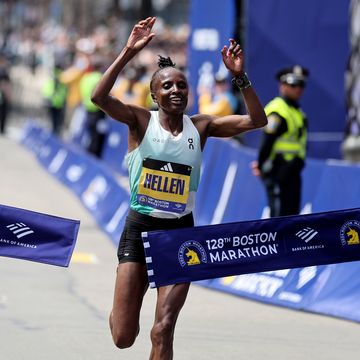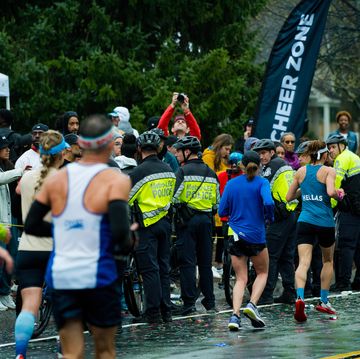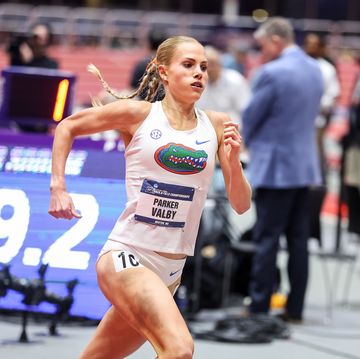Since April, Ben True has won two road races and one track 5K by outkicking world-class competitors from other countries. In the case of the track race, the Diamond League meet in New York City on June 13, he defeated Nick Willis, the New Zealand record holder at 1500 meters and 2008 Olympic silver medalist at the distance.
So when the 29-year-old American says “I should have a good shot” at medaling in the 5,000 meters at the IAAF World Championships in Beijing, he’s not being unreasonable. Optimistic? Yes. Ambitious? Sure. After all, it will be his first global track championship, and 11 men in the field have a better personal best than True’s 13:02.74. But at meets of this caliber, tactics and timing—being on a performance upswing—are at least as important as numbers on paper.
“This year no one has closed any [world-class 5Ks] faster than 54 seconds,” True says. “That seems to be the general closing last lap for all the Diamond League races. That’s definitely in my wheelhouse.” True says his last lap in his New York Diamond League win was “54-high.”
In winning the last three global 5,000-meter titles, Mo Farah’s final laps were 53.52 at the 2013 world championships, 52.94 at the 2012 Olympics, and 52.61 at the 2011 world championships. Farah’s finishing time in those races ranged from 13:23 to 13:41. True is hoping the final in Beijing will be quicker.
“An ideal situation is that there’d be a relatively quick race, more in the 13:05-13:10 range, coming down to a hard kick,” he says. “I think at that speed my kick will be just as strong as other people’s. It comes down to having good position and staying out of most of the surging and fartleking games, and conserving energy for the last 600 meters.”
GET MORE NEWSWIRE: Sign up for the RW Daily newsletter
Yet a steady, relatively fast pace in the August 29 final is unlikely. Defending champion Farah will be doubling back from the 10K, and will be content to run easily for as many of the race’s 12.5 laps as possible. At recent championships, neither Kenyans nor Ethiopians have tried to employ team tactics to defeat Farah, despite repeated evidence that leaving the race to a sprint favors him.
“If that’s the case, I just have to conserve as much as possible and get ready to go for the last kilometer and make sure I’m watching every single move,” True says. “I don’t think it would be wise for me to take the pace out with a ways to go because there are so many other strong and accomplished runners. That wouldn’t be my best way of finishing well. I’m not planning on doing any sort of leading until the very, very end.”
True is less of a pure track runner than many of the men he’ll face in Beijing. Despite his confidence in his kick, he doesn’t know what his 200-meter best is. This spring, he won April’s B.A.A. 5K in an American road record of 13:22 and the Healthy Kidney 10K in Central Park. In 2013, he was sixth at the world cross country championships. He doesn’t buy the argument that he should specialize in track races to hone the right rhythm and tactical sensibility for the oval.
“I think running is running,” True says. “Whether you’re running on pavement or the track or grass, it’s all just running. I don’t know why more people don’t run more road races. I think they’re fun, and they offer great prize money. I think that not only are they good races but also good training—it’s a good exercise in pure competition because you’re not worried about time.”
That basic, non-obsessive approach is reflected in True’s training. Unlike most of his fellow distance runners on the U.S. team for Beijing, he does almost all of his running by himself. Tim Broe, the 2004 Olympic Trials 5,000-meter winner, coaches him remotely. The relationship is more a sharing of ideas between similar minds than the prescriptive close monitoring in a traditional coach-athlete set-up.
“Tim’s been watching my workouts once a week or every other week,” True said in early August. “That’s been quite nice, to have someone holding a stopwatch and yelling splits and having the camaraderie of another human present at the track.”
True has tried group training, and not living in New England, and found neither fit him. A native of Maine, he lives in Hanover, New Hampshire, home of his alma mater, Dartmouth College. After graduating from Dartmouth in 2009, he joined the Oregon Track Club. He lasted fewer than 10 months in the Pacific Northwest.
“It just wasn’t for me,” True says. “I’m a homebody, I like New England. It was a hard realization because they were great support and I knew there were tons of people who would have been happy to have that opportunity. I felt almost like a failure, because I wasn’t running well there. I thought, ‘If I can’t run well there, how can I ever run well?’ But eventually I was so far gone [from running well] that I figured I’ll go off by myself, and if that doesn’t work out I guess I’m done running.”
Within a year of returning to New England, True placed second at the 2011 U.S. 15K championship (to Mo Trafeh, who later received a doping ban) and was the top American man at the 2011 world cross country championships. His times or competitive record have improved every year since.
While at Dartmouth, True was an All-American in Nordic skiing as well as cross country and track. From skiing he learned how to work by effort more than pace. The ability to accurately read his body has served him well as a world-class runner training on his own.
“When I’m really tired and struggling in a workout, that’s my body telling me today’s not the day to be running hard and that I need to recover a little bit more,” True says. “In a group setting it’s easier for me to push and get caught up in the group atmosphere and get set back.
“I know the feeling of not having it that day and maybe running five seconds slower [per interval] and that I’ll still get the benefit that workout is supposed to give,” he says. “And I know the feeling of being utterly exhausted and your body’s shutting down and there’s no point in going any farther. Then you just need to step off the track. That’s a benefit of training by myself.”
True does have regular contact with at least one other elite endurance athlete. His wife, Sarah, was fourth in the triathlon at the 2012 Olympics and has already been named to the 2016 team. They often discuss the use of performance-enhancing drugs by other elites. True favors disallowing Therapeutic Use Exemptions (TUEs), which allow an athlete to take prescription medications that are otherwise banned if a physician says the athlete has a medical need. True says the system for obtaining TUEs is too easily abused by athletes seeking a performance benefit from the medication.
“I have a hard time with the idea that if you’re that sick and need certain drugs that you’re able to be at the top of the sport and race at the highest level,” True says. “Maybe you just need to go home and rest and recover for a while.
“It’s a very slippery slope when you allow someone to take drugs to help cure things,” he says. “It’s hard luck, but that’s the hand you were dealt and you have to play with the hand you were dealt.”
True won’t carry those thoughts to the track in Beijing.
“You have to push it out of your head when you toe the starting line because you can’t ever think, ‘This person might be doping and I can’t beat them,’” he says. “I feel like I can beat them as a clean athlete. When the gun goes off, I’m just trying to beat that person. If you do beat them and there’s suspicion around them, then it’s a sweeter victory.”

Scott is a veteran running, fitness, and health journalist who has held senior editorial positions at Runner’s World and Running Times. Much of his writing translates sport science research and elite best practices into practical guidance for everyday athletes. He is the author or coauthor of several running books, including Running Is My Therapy, Advanced Marathoning, and Meb for Mortals. Scott has also written about running for Slate, The Atlantic, the Washington Post, and other members of the sedentary media. His lifetime running odometer is past 110,000 miles, but he’s as much in love as ever.


